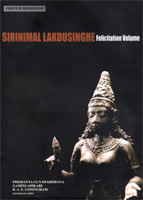This felicitation volume dedicated to renowned scholar Sirinimal Lakdusinghe is perhaps the greatest contribution in the field of Sri Lankan archaeology in recent times. The contributions by no less than 45 distinguished scholars in this exciting field makes some of the most interesting reading on the subject one can ever come across in a single volume – and not just for the professional archaeologist, but just about for anyone interested in the country’s long and eventful history.
Among the contributions I found particularly interesting was Prof. Senake Bandaranayake’s fascinating reconstruction of the Lion Palace of Sigiriya in his well-researched paper ‘Sigiriya: Notes on the Conjectural Reconstruction of the Palace and the Lion Staircase’. The paper, which is replete with hypothetical reconstructions of the palace complex and the colossal Sphinx-like lion figure that gave it its name of Sigiriya, or ‘Lion Rock’ arrives at some interesting conclusions as to how the structure would have looked like in its heyday.
Of particular interest is the so-called Sunset Pavilion perched at the southern extremity of the upper palace where the ridge of the zone is at its narrowest, thus affording it a nearly 360 degree view of the horizon, making it the ideal spot to view the sunset over the famous water gardens of Sigiriya.
Another revealing contribution, ‘Horton Plains as a World Heritage Site’, by Dr. T.R. Premathilake attempts to show that the Horton Plains of Central Sri Lanka was the home of an incipient prehistoric farming community that engaged in rice cultivation several millennia ago as indicated by the presence of phytoliths (siliceous micro-fossils) of Oryza Sp (cultivated rice).
This is quite a revelation considering the hitherto held belief that rice cultivation was introduced by Indo-Aryan settlers from India only around the 5th century B.C. It also provides a basis for the country to stake a claim as one of the earliest centres of human civilization where agriculture had been developed independently to a high level as far back as 15,000 to 13,000 years ago by hunter-foragers who had somehow acquired the technique and practices to convert wild plants into domestic ones.
This compares favourably with other ancient sites of cereal cultivation such as Xian Rendong in China which goes back to 14,000 years ago and other sites such as Abu Hureyra in the Euphrates and Ghaba Valley in Syria going back to 13,000 years ago.
Nimal De Silva’s contribution, ‘Magama’, the ancient capital of Ruhuna reveals some interesting facets in urban planning of the ancient city of Magama which served as the capital of the southern Ruhuna kingdom from 3rd century B.C. for nearly fourteen hundred years. Originally a large village as evident from its name Maha-gama or ‘Great Village’, its development was greatly facilitated by its proximity to the Kirindi Oya, so much so that it had within a short time developed into a substantial metropolis with trade links with India and the Roman Empire. This is evident from archaeological findings such as Indian red polished ware and Roman roulette ware.
Melathi Saldin’s ‘Megalithic burials and Anuradhapura’, discusses the reasons for the absence of megalithic cist burials in the immediate vicinity of Anuradhapura city which is conspicuous for the absence of megalithic burial sites found in many other parts of the island, particularly in the North Central plains. In her thought-provoking paper, Saldin seeks to reassess the commonly accepted hypothesis that the megalithic burials belonged to a group of pastoral nomads on the periphery of those who occupied Anuradhapura, and concludes that the lack of field work done in this regard could be one of the reasons for their non-discovery, though she does not rule out the effects of city expansion from early times up to the present day and the possible destruction of such burial sites due to agricultural and other human activities which is not untenable given that many of the Dry Zone cist burials are located in the fertile reddish brown Earth Zone of the island.
W.H. Wijayapala’s ‘Pre-historic bone artifacts from Sri Lanka’ gives us an insight into some of the earliest instances of animal bones used for manufacturing artifacts where we find a tendency to select the bones of smaller animals for fashioning such artifacts which were probably used to hunt small animals. This is lent support by an analysis of faunal remains gathered from cave sites such as Alulena and Belilena where the majority of remains were of smaller animals such as hare, monkey and porcupine. Further, as borne out by the remains of fish bones from Kitulgala and Batadombalena, fishing was evidently practised by prehistoric man in Sri Lanka, and it is suggested that shanks of jungle fowl with spurs on them were possibly used for this purpose.
Another interesting paper by Senarath Dissanayake, ‘Fertility Cult that existed in Sri Lanka before the Advent of Buddhism’, seeks to connect the mare-faced Yakkhini named Valavamukhi who figures in the Mahavamsa as an ally of King Pandukabhaya with Parvati, particularly in her aspect as Durga on the basis of certain similarities such as connection with mountains and warfare.
Among other notable contributions one would find Nanda Wickramasinghe’s ‘Technique of Sigiriya Paintings’, Senarath Wickramasinghe’s ‘Study of a hoard of punch-marked coins found at Mirigama’ and Jayampath Senanayake and Roshani Rammungoda’s ‘Petroglyphs of Urakanda- Sri Lanka’.
This volume is no doubt the most noteworthy contribution to modern Sri Lankan archaeology and is a must-read for all those who are interested in this fascinating subject. |


